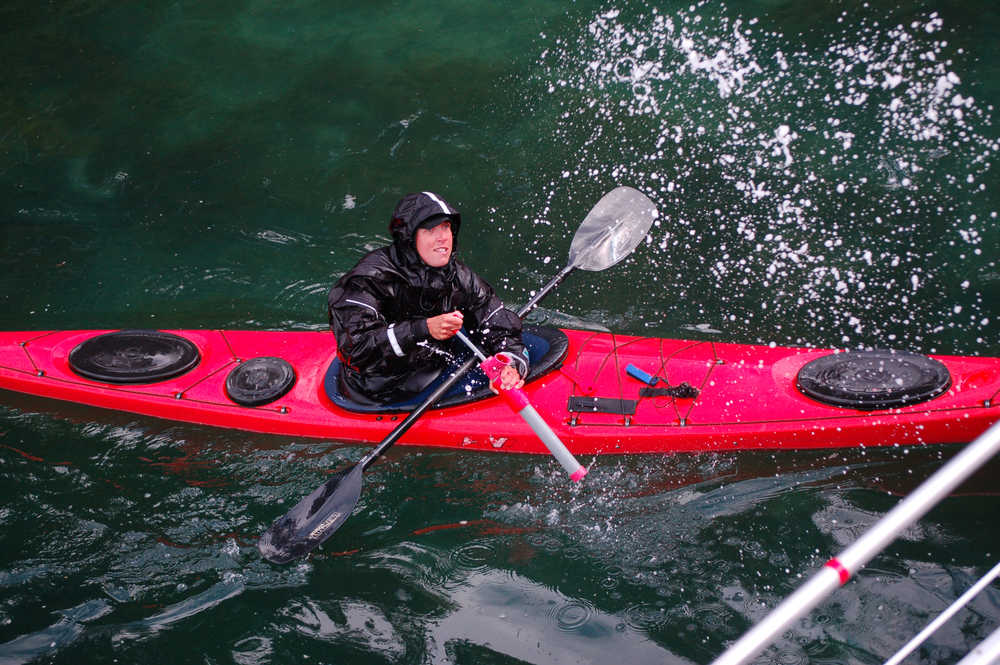Kayaking, though a popular summer activity in Homer, can prove dangerous if not approached with the proper information and equipment.
“Homer has had, I think, two kayak deaths. There have been numerous people who have gotten into trouble and had to be rescued,” said True North Kayak Adventures founding member Alison O’Hara. “That happens occasionally and that can be the realm of people not being aware of the tides … and get swept out to sea. Kayaks tip over. The occasional person gets into trouble because of poor judgment or the weather kicks in.”
A San Diego couple was rescued from Kachemak Bay when they were unable to get back to shore on a return trip from Gull Island on July 5. The kayakers misjudged the tide and made a 911 call about 8:30 p.m., asking for medical assistance.
Though they wore dry suits and had safety gear with them, they did not have a marine radio. Radios are a must-have while kayaking in the Homer area, O’Hara said.
“People need to have some sort of communication. VHS radios, a marine handheld radio, are handy. If you are at the head of Tutka Bay and you can’t get cell phone access — or even if you can — you can contact the boats that are nearby,” O’Hara said. “(For example) ‘Mayday, Mayday, I’ve got someone having a heart attack. I’m at the south side of the bay.’”
“The distress channel is 16. That will alert the Coast Guard. Everybody stands by on channel 16. It’s a great way to hail the universe,” O’Hara said.
In addition to a radio, kayakers should also wear a personal floatation device (PFD) and carry a first aid kit, repair kit, a change of fast-drying clothes, extra food and water, and fire starter if they are going for a longer trip.
All kayaks should have flotation — air bladders or sealed bulkheads — so the boat does not sink if it flips and fills with water.
Tide books can be found for free from the Homer Chamber of Commerce and Cook Inletkeeper or local stores such as Ulmer’s and Redden Marine-Kachemak Gear Shed. An online search for “Kachemak Bay Tide Tables” will pull up the same information, O’Hara said.
O’Hara also recommends TideApp, a smartphone app which not only gives high and low tide times, but tells the viewer how many feet of water there is at any given time, she said.
Kayakers going more than 15 minutes from shore should also dress in preparation for immersion in the water in case they end up in the chilly bay. Dry suits are recommended, though a thick wet suit can be used as well.
“The water is cold, about 50 degrees, so you have about 15 minutes to survive depending on your body fat content, so there’s not a lot of room for error,” O’Hara said. “If you’re totally submerged in it and you don’t know how to rescue yourself or your friends, things can go awry pretty rapidly.”
Those who are new to kayaking should take a beginners kayaking class, said Homer Coast Guard Marine Safety Detachment Chief Warrant Officer Keith McKinney. Leaving a float plan behind with someone on shore and kayaking in pairs is also recommended, McKinney said.
“Always leave a float plan behind. Leave behind a plan with a person on shore and say, ‘Hey I’m going over here and if I’m not back by this time, call for help,’” McKinney said. “You should kayak in pairs. That way if something happens, someone’s there to see, witness and help assist.”
Only extremely experienced kayakers should attempt to cross the bay from the Spit on their own, O’Hara said.
Otherwise, kayakers should take a water taxi to less difficult areas and consider going out on the water with a guide.
“The advice I’d offer to the casual paddler would be to hire a guide or venture out only in protected waters in favorable conditions, with the right equipment and an honest set of conservative expectations,” said sea kayaker, former wilderness guide and instructor Bjorn Olson.
Anna Frost can be reached at anna.frost@homernews.com.


